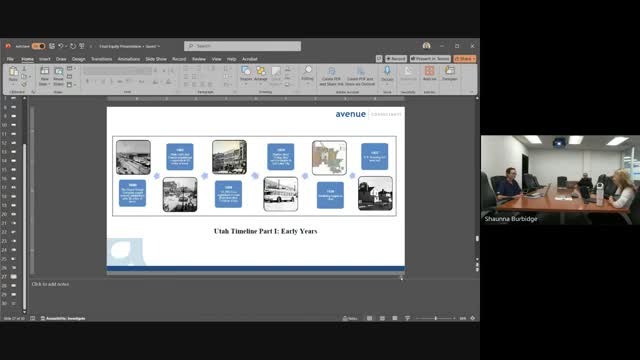Utah's suburban boom reshapes transportation and housing landscape
October 13, 2024 | Utah Department of Transportation, Utah Transportation, State Agencies, Organizations, Utah Executive Branch, Utah
This article was created by AI summarizing key points discussed. AI makes mistakes, so for full details and context, please refer to the video of the full meeting. Please report any errors so we can fix them. Report an error »

In a recent government meeting, officials discussed the historical evolution of transportation and urban development in Utah, highlighting key milestones that have shaped the state's infrastructure and community dynamics.
The conversation began with a look back at the inception of rapid transit in Salt Lake City in 1890, which laid the groundwork for a growing network that expanded to 80 miles by 1903. However, the rise of automobile ownership marked a significant shift in transportation habits, with registered vehicles skyrocketing from 7,000 in 1914 to 91,000 by 1926. Initially, these vehicles were primarily used for recreational purposes, but this trend evolved into a reliance on cars for daily activities.
The introduction of rubber-tired buses in 1928 and the subsequent establishment of redlining practices in 1934 were pivotal moments that influenced urban planning and housing accessibility. The 1937 US Housing Act aimed to provide homes for all Americans, further contributing to suburbanization trends that gained momentum post-World War II, particularly with the introduction of VA loans for returning veterans.
The meeting also addressed the impact of infrastructure developments, such as the construction of I-15 starting in 1957, which facilitated suburban expansion and led to what was described as \"white flight\" to the suburbs. The Bamberger rail line, operational during this period, complemented road developments and supported the movement of residents to suburban areas.
Environmental considerations began to emerge with the Air Quality Act of 1967, while the Fair Housing Act of 1968 sought to eliminate redlining practices. Despite these advancements, the meeting underscored the lasting effects of historical policies on current urban landscapes.
As the discussion progressed into the 21st century, officials noted a rapid population increase leading to further suburban and exurban development, particularly in northern Davis County and Weber County. The affordability of housing in these areas has driven new growth, resulting in a heightened dependence on automobiles for transportation.
Overall, the meeting provided a comprehensive overview of how historical transportation and housing policies have shaped Utah's urban development, revealing ongoing challenges and trends that continue to influence the state's infrastructure and community planning.
The conversation began with a look back at the inception of rapid transit in Salt Lake City in 1890, which laid the groundwork for a growing network that expanded to 80 miles by 1903. However, the rise of automobile ownership marked a significant shift in transportation habits, with registered vehicles skyrocketing from 7,000 in 1914 to 91,000 by 1926. Initially, these vehicles were primarily used for recreational purposes, but this trend evolved into a reliance on cars for daily activities.
The introduction of rubber-tired buses in 1928 and the subsequent establishment of redlining practices in 1934 were pivotal moments that influenced urban planning and housing accessibility. The 1937 US Housing Act aimed to provide homes for all Americans, further contributing to suburbanization trends that gained momentum post-World War II, particularly with the introduction of VA loans for returning veterans.
The meeting also addressed the impact of infrastructure developments, such as the construction of I-15 starting in 1957, which facilitated suburban expansion and led to what was described as \"white flight\" to the suburbs. The Bamberger rail line, operational during this period, complemented road developments and supported the movement of residents to suburban areas.
Environmental considerations began to emerge with the Air Quality Act of 1967, while the Fair Housing Act of 1968 sought to eliminate redlining practices. Despite these advancements, the meeting underscored the lasting effects of historical policies on current urban landscapes.
As the discussion progressed into the 21st century, officials noted a rapid population increase leading to further suburban and exurban development, particularly in northern Davis County and Weber County. The affordability of housing in these areas has driven new growth, resulting in a heightened dependence on automobiles for transportation.
Overall, the meeting provided a comprehensive overview of how historical transportation and housing policies have shaped Utah's urban development, revealing ongoing challenges and trends that continue to influence the state's infrastructure and community planning.
View full meeting
This article is based on a recent meeting—watch the full video and explore the complete transcript for deeper insights into the discussion.
View full meeting

